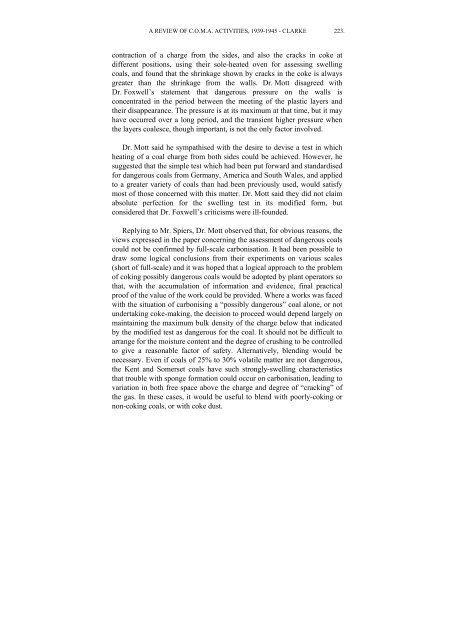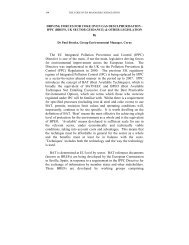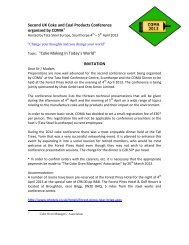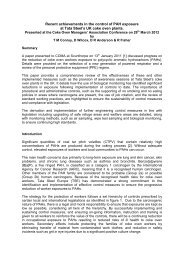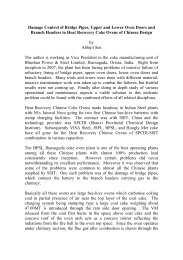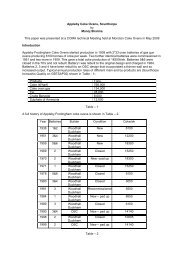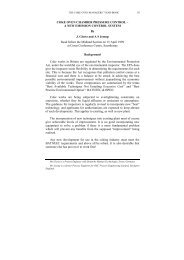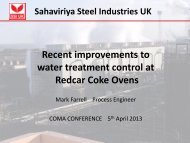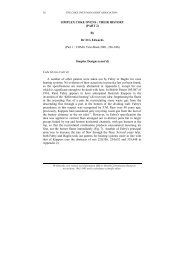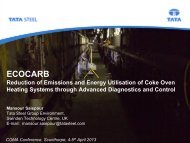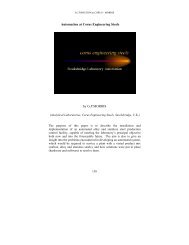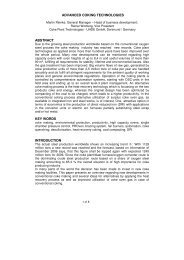CHAIRMAN'S ADDRESS - Coke Oven Managers Association
CHAIRMAN'S ADDRESS - Coke Oven Managers Association
CHAIRMAN'S ADDRESS - Coke Oven Managers Association
- No tags were found...
Create successful ePaper yourself
Turn your PDF publications into a flip-book with our unique Google optimized e-Paper software.
A REVIEW OF C.O.M.A. ACTIVITIES, 1939-1945 - CLARKE 223.contraction of a charge from the sides, and also the cracks in coke atdifferent positions, using their sole-heated oven for assessing swellingcoals, and found that the shrinkage shown by cracks in the coke is alwaysgreater than the shrinkage from the walls. Dr. Mott disagreed withDr. Foxwell’s statement that dangerous pressure on the walls isconcentrated in the period between the meeting of the plastic layers andtheir disappearance. The pressure is at its maximum at that time, but it mayhave occurred over a long period, and the transient higher pressure whenthe layers coalesce, though important, is not the only factor involved.Dr. Mott said he sympathised with the desire to devise a test in whichheating of a coal charge from both sides could be achieved. However, hesuggested that the simple test which had been put forward and standardisedfor dangerous coals from Germany, America and South Wales, and appliedto a greater variety of coals than had been previously used, would satisfymost of those concerned with this matter. Dr. Mott said they did not claimabsolute perfection for the swelling test in its modified form, butconsidered that Dr. Foxwell’s criticisms were ill-founded.Replying to Mr. Spiers, Dr. Mott observed that, for obvious reasons, theviews expressed in the paper concerning the assessment of dangerous coalscould not be confirmed by full-scale carbonisation. It had been possible todraw some logical conclusions from their experiments on various scales(short of full-scale) and it was hoped that a logical approach to the problemof coking possibly dangerous coals would be adopted by plant operators sothat, with the accumulation of information and evidence, final practicalproof of the value of the work could be provided. Where a works was facedwith the situation of carbonising a “possibly dangerous” coal alone, or notundertaking coke-making, the decision to proceed would depend largely onmaintaining the maximum bulk density of the charge below that indicatedby the modified test as dangerous for the coal. It should not be difficult toarrange for the moisture content and the degree of crushing to be controlledto give a reasonable factor of safety. Alternatively, blending would benecessary. Even if coals of 25% to 30% volatile matter are not dangerous,the Kent and Somerset coals have such strongly-swelling characteristicsthat trouble with sponge formation could occur on carbonisation, leading tovariation in both free space above the charge and degree of “cracking” ofthe gas. In these cases, it would be useful to blend with poorly-coking ornon-coking coals, or with coke dust.


